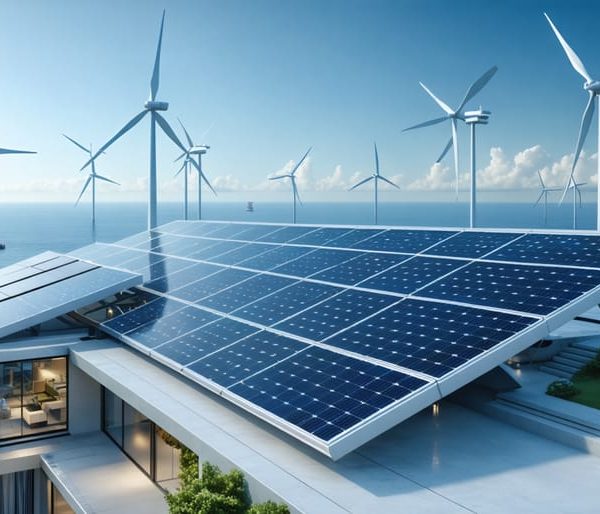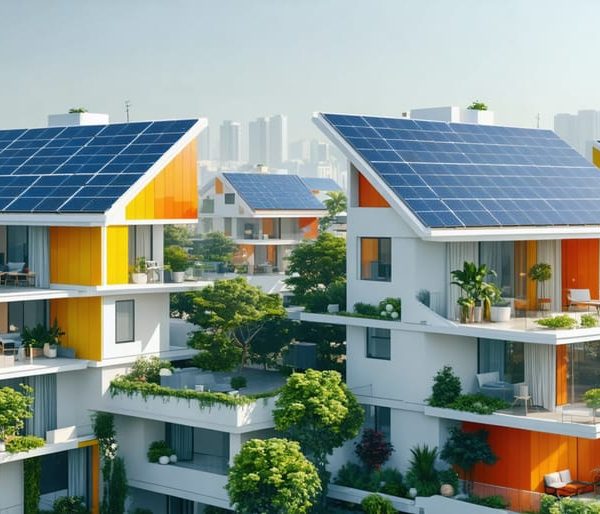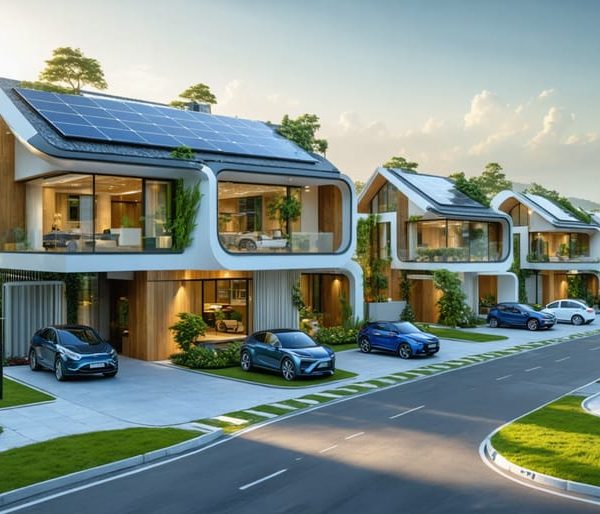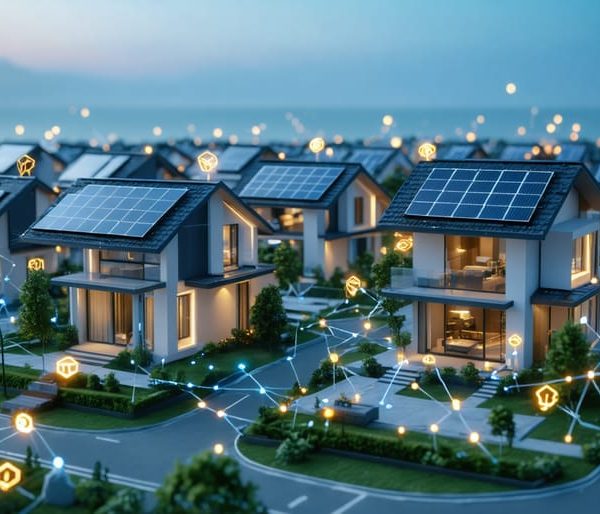Building Integrated Solar Panels That Pay For Your Roof
Imagine transforming your building’s surfaces into powerful energy generators. Building Integrated Photovoltaics (BIPV) seamlessly merge solar technology with architectural design, turning ordinary windows, walls, and roofs into clean energy producers. Unlike traditional solar panels mounted on top of existing structures, BIPV systems become an integral part of the building itself, serving dual purposes as both construction materials and power generators.
This innovative approach to sustainable architecture is revolutionizing how we think about energy efficiency in modern buildings. By incorporating solar cells directly into building materials, BIPV systems eliminate the need for separate panel installations while maintaining aesthetic appeal. From semi-transparent solar windows that provide natural lighting while generating electricity, to solar roof tiles that look indistinguishable from traditional materials, BIPV technology offers a sophisticated solution for property owners seeking to combine sustainability with style.
As cities worldwide push for greener building practices and energy independence, BIPV represents the future of sustainable construction. Not only does it reduce a building’s carbon footprint, but it also offers significant long-term cost savings through reduced energy bills and increased property value. This introduction to BIPV opens the door to understanding how your property can become part of the clean energy revolution while maintaining its architectural integrity.
How BIPV Transforms Your Building’s Exterior Into a Power Plant
Beyond Traditional Solar Panels
While traditional solar panels sit on top of existing roofs or structures as add-on components, BIPV systems take a more integrated approach by becoming part of the building itself. Conventional panels are typically mounted on metal racks and require additional hardware, which some property owners find visually distracting. In contrast, BIPV materials seamlessly blend into the building’s design, serving dual purposes as both construction materials and power generators.
Think of BIPV as a suit tailored to fit perfectly, while traditional solar panels are more like a one-size-fits-all jacket. BIPV systems can replace regular building materials in roofs, windows, facades, and skylights, potentially reducing overall construction costs. They offer architects and designers greater creative freedom, allowing for more aesthetically pleasing installations that maintain the building’s architectural integrity.
Another key difference lies in their installation process. Traditional panels typically require a separate installation phase after construction, while BIPV systems are incorporated during the building process or renovation, streamlining the overall project timeline and potentially reducing labor costs.

BIPV Building Materials That Generate Power
Today’s market offers an exciting range of BIPV products that seamlessly integrate solar power generation into building materials. Solar roof tiles, which look identical to traditional shingles, have become increasingly popular among homeowners seeking a subtle solar solution. These innovative tiles protect your roof while generating clean energy.
Another breakthrough comes in the form of smart solar walls that incorporate photovoltaic elements into facade materials. These can include solar glass windows that remain transparent while capturing sunlight, and solar cladding panels that serve as both insulation and power generators.
For commercial buildings, solar skylights offer a dual benefit of natural lighting and energy production. Solar awnings and canopies provide shade while converting sunlight into electricity. Even balcony railings can now be equipped with solar cells, turning previously unused surfaces into power-generating assets.
The latest BIPV materials feature improved efficiency and durability, with some products offering warranties of up to 25 years, making them a reliable long-term investment for sustainable construction.
Smart Ways BIPV Saves Money and Space
Double-Duty Construction Materials
One of the most compelling advantages of building integrated photovoltaics is their ability to serve two purposes simultaneously, leading to significant cost savings. Instead of purchasing traditional building materials and solar panels separately, BIPV systems replace conventional construction elements while generating clean energy.
For example, BIPV roof tiles eliminate the need for standard roofing materials, effectively cutting material costs. Similarly, when used as building facades or windows, these systems replace traditional glass panels or cladding materials, offsetting their initial cost. This dual functionality means you’re not just paying for solar technology – you’re investing in essential building components that would be necessary anyway.
The cost benefits extend beyond material savings. By integrating solar technology during construction or renovation, you reduce labor costs associated with separate installations. There’s also less structural reinforcement needed compared to traditional roof-mounted solar panels, as BIPV systems are designed to be part of the building’s structure.
Many property owners find that the combined savings from eliminated building materials and reduced installation costs can offset 40-60% of the BIPV system’s initial price. When factored together with long-term energy savings and potential government incentives, the financial benefits become even more attractive. This makes BIPV an increasingly practical choice for both new construction and renovation projects.

Energy Generation Benefits
Building integrated photovoltaics (BIPV) offer impressive power generation capabilities that can transform your property into an energy-producing asset. These systems excel at slashing energy bills while providing a sustainable power source for your building’s needs.
A typical BIPV installation can generate between 10 to 30 watts per square foot, depending on the solar cell efficiency and available sunlight. For perspective, a 1,000-square-foot roof area could potentially generate 10-30 kilowatts of power during peak sunlight hours. This output can significantly offset your building’s energy consumption, with many property owners reporting 40-60% reductions in their electricity costs.
The beauty of BIPV systems lies in their constant power generation during daylight hours. Unlike traditional energy sources, BIPV produces clean electricity without ongoing fuel costs or significant maintenance expenses. Many installations include smart monitoring systems that allow you to track power generation in real-time, helping you optimize energy usage and maximize savings.
During peak production hours, excess energy can be fed back into the grid, potentially earning you credits through net metering programs. Some property owners even achieve net-zero energy status, where their annual energy production matches or exceeds their consumption, effectively eliminating their electricity bills altogether.
Real-World BIPV Applications That Work
Residential Success Stories
The Thompson family in Colorado transformed their 1960s ranch-style home with sleek BIPV roof tiles, seamlessly integrating solar power while maintaining their home’s classic aesthetic. Within the first year, they reduced their energy bills by 85% and increased their property value by $45,000. This success story is just one example of how solar technology is revolutionizing homes across America.
In Seattle, the Martinez residence incorporated BIPV glass windows on their south-facing walls, combining natural lighting with power generation. Despite the region’s frequent cloud cover, their system generates enough electricity to power their essential household needs, saving them $2,400 annually.
The Wilson’s modern farmhouse in Texas showcases how BIPV can blend with traditional architecture. Their solar roof shingles and power-generating siding materials produce 12,000 kWh annually, making their home completely energy independent. Plus, the sophisticated design has inspired five neighboring families to adopt similar systems.
These success stories demonstrate how BIPV technology can enhance both the functionality and aesthetics of residential properties while delivering substantial energy savings and environmental benefits.
Commercial Building Transformations
Commercial properties worldwide are leading the charge in BIPV adoption, showcasing how to revolutionize your building with sustainable technology. The CopenHill power plant in Copenhagen features a striking facade of aluminum, glass, and solar panels that generates clean energy while maintaining its architectural appeal. In Singapore, the Apple Marina Bay Store demonstrates how curved solar glass can create a stunning visual impact while producing renewable energy.
The CIS Tower in Manchester underwent a remarkable transformation by incorporating 7,000 solar panels into its facade, becoming one of the largest vertical solar arrays in Europe. This retrofit not only reduced the building’s carbon footprint but also created an iconic landmark that inspires other commercial properties to embrace BIPV solutions.
The Pearl River Tower in Guangzhou, China, showcases how BIPV can be integrated from the initial design phase. Its double-skin facade includes photovoltaic panels that power the building while reducing solar heat gain. These successful implementations prove that commercial BIPV projects can balance aesthetic appeal with environmental responsibility, inspiring property owners to consider similar sustainable upgrades for their buildings.

Installing BIPV: What You Need to Know
Planning Your BIPV Project
Before embarking on your BIPV project, careful planning is essential to ensure optimal performance and return on investment. Start by assessing your building’s solar potential through a professional site evaluation. This includes analyzing sun exposure, shade patterns, and structural integrity of your property.
Consider your energy goals and budget carefully. Are you aiming for complete energy independence or looking to offset a portion of your power consumption? Understanding your objectives will help determine the scope of your BIPV installation.
Work with qualified architects and solar installers who have specific experience with BIPV systems. They can help you select appropriate materials that complement your building’s aesthetics while maximizing energy generation. Remember to check local building codes, zoning regulations, and obtain necessary permits before proceeding.
Think about the long-term maintenance requirements. While BIPV systems generally require minimal upkeep, you’ll want to ensure easy access for cleaning and repairs. Also, consider how the system will affect your building’s insulation and weatherproofing properties.
Don’t forget to explore available incentives and financing options. Many regions offer tax credits, rebates, or grants for BIPV installations. Calculate your expected energy savings and ROI timeline to make an informed decision.
Finally, develop a realistic project timeline that accounts for design, permitting, installation, and system commissioning. Good planning now will lead to smoother implementation and better results later.
Professional Installation Requirements
Installing BIPV systems requires specialized knowledge and expertise, making professional installation a must. Unlike traditional solar panels, BIPV components are integral parts of your building’s structure, demanding both solar technology expertise and construction experience.
Licensed electricians with solar certification should handle the electrical integration aspects of BIPV installation. These professionals understand both conventional electrical systems and the unique requirements of photovoltaic technology. They ensure proper connections, grounding, and compliance with electrical codes.
Installers should hold certification from recognized organizations such as the North American Board of Certified Energy Practitioners (NABCEP) or equivalent regional certifications. These credentials demonstrate their competence in designing and installing solar energy systems safely and effectively.
The installation team should also include experienced construction professionals who understand building envelope systems, waterproofing, and structural requirements. This expertise is crucial since BIPV elements must maintain the building’s integrity while generating power.
Before hiring an installation team, verify their:
– Valid licenses and certifications
– Experience with BIPV specifically
– Insurance coverage
– Knowledge of local building codes
– Track record of successful installations
Working with certified professionals not only ensures proper installation but often helps maintain warranty coverage and may be required for obtaining necessary permits and inspections. Many manufacturers also provide specialized training for their BIPV products, so look for installers who have completed these product-specific programs.
Building integrated photovoltaics represents a groundbreaking shift in how we think about solar energy and sustainable architecture. By seamlessly combining renewable energy generation with building materials, BIPV offers a sophisticated solution that addresses both environmental concerns and aesthetic preferences. The technology has already proven its worth in numerous projects worldwide, from residential homes to commercial skyscrapers, demonstrating its versatility and effectiveness.
As we look to the future, BIPV technology continues to evolve with more efficient panels, improved aesthetics, and decreasing costs. The growing focus on green building standards and zero-energy buildings suggests that BIPV will play an increasingly important role in sustainable architecture. For property owners, the combination of energy savings, increased property value, and environmental benefits makes BIPV an attractive investment.
With continuous advancements in materials and installation techniques, BIPV is becoming more accessible to homeowners and businesses alike. As we move toward a more sustainable future, building integrated photovoltaics stands out as a practical and elegant solution that transforms our buildings from energy consumers into clean power generators, while maintaining their architectural integrity.











